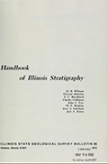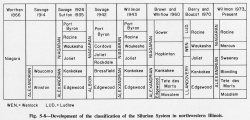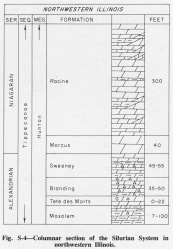Historical:Mosalem Formation: Difference between revisions
mNo edit summary |
(No difference)
|
Latest revision as of 23:56, 4 January 2017
Lithostratigraphy: Hunton Limestone Megagroup >>Mosalem Formation
Chronostratigraphy: Paleozoic Erathem >>Silurian System >>Alexandrian Series
Allostratigraphy: Tippecanoe Sequence
Authors
H. B. Willman and Elwood Atherton
Name Origin
The Mosalem Formation is named for Mosalem Township in Dubuque County, Iowa.
Type Section
The type section, a roadcut south of the village of King (E1/2 SE 27, 88N-3E) exposes the upper 60 feet, nearly the entire thickness.
Other Names
The Mosalem strata were originally named "Winston" (Savage, 1914) for exposures at the east end of the railroad tunnel at Winston, Jo Daviess County, but later were included in the Edgewood Formation (fig. S-8).
Correlation
The Mosalem is similar in character to the Wilhelmi Formation in northeastern Illinois and probably is equivalent to part of the Edgewood Formation in western and southern Illinois.
Extent and Thickness
The Mosalem is well exposed in many places in northwestern Illinois north of the Savanna Anticline and is as much as 100 feet thick where it fills channels eroded into the Maquoketa Shale Group. Typical thick exposures can be seen in the Mississippi River bluffs 6 miles south of Galena (SE SW SE 21, 27N-1E) and south of Pearl City, Stephenson County (NE cor. 17, 26N-6E). The formation is generally much thinner and is only 7 feet thick in Mississippi Palisades State Park north of Savanna, Carroll County (SW NE SE 28, 25N-3E).
Stratigraphic Position
The Mosalem Formation (Brown and Whitlow, 1960, p. 36) is the basal formation in the Alexandrian Series in northwestern Illinois (fig. S-4). Brown and Whitlow named the Mosalem and the overlying Tete des Morts as members of the Edgewood Formation, but, because they are distinctly different in lithology, Willman (1973, p. 31) made them separate formations and discontinued the use of Edgewood in northwestern Illinois.
Description
The Mosalem grades from very argillaceous, medium to dark gray dolomite and dolomitic shale at the base in the thick sections, to moderately argillaceous, fine-grained, dense, gray, yellow-brown-weathering dolomite at the top. It differs from the overlying Tete des Morts Formation in being more argillaceous and thinner bedded and in containing a few bands of white chert nodules and several thin, pure, vesicular, fossiliferous, laminated beds. Where thin, the Mosalem is slightly to moderately argillaceous and thick bedded.
Fossils
The formation is largely nonfossiliferous, but Savage (1914) listed a small fauna.
References
BROWN, C. E., and J. W. WHITLOW, 1960, Geology of the Dubuque South Quadrangle, Iowa-Illinois: USGS Bulletin 1123-A, p. 1-93.
SAVAGE, T. E., 1914, Relations of the Alexandrian Series in Illinois and Missouri to the Silurian section of Iowa: American Journal of Science, v. 38, p. 28-37.
WILLMAN, H. B., 1973, Rock stratigraphy of the Silurian System in northeastern and northwestern Illinois: Illinois State Geological Survey Circular 479, 55 p.
ISGS Codes
| Stratigraphic Code | Geo Unit Designation |
|---|---|


